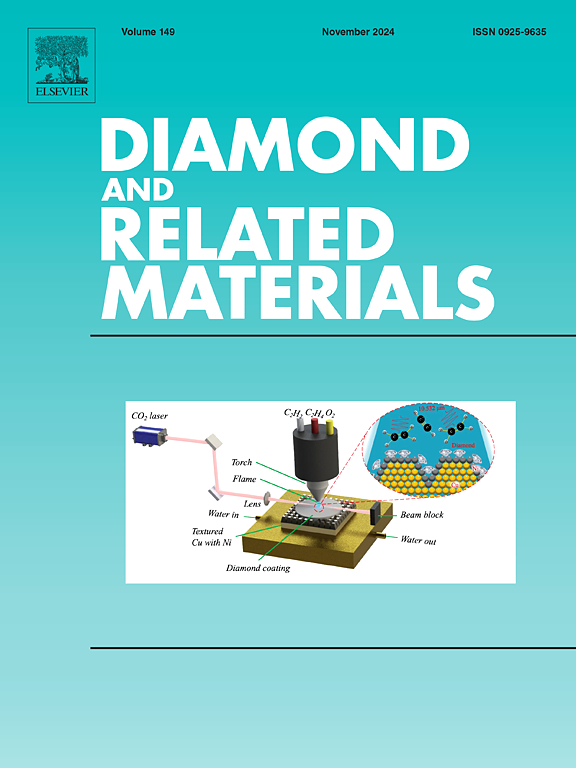Low-leakage-current and improved thermal stability of normally-OFF hydrogen-terminated diamond FET via boron nitride passivation
IF 5.1
3区 材料科学
Q2 MATERIALS SCIENCE, COATINGS & FILMS
引用次数: 0
Abstract
Normally-OFF hydrogen-terminated diamond (H-diamond) field-effect transistor (FET) with low leakage current is highly desirable for energy-saving switching applications. Metal/H-diamond FET with Schottky gate exhibits potential application advantages, owing to its excellent switching speed and small subthreshold swing. However, a lower interface barrier height (Schottky junction) typically results in high leakage current and poor thermal stability. In this work, a normally-OFF H-diamond metal/insulator/semiconductor-metal/semiconductor hybrid gate FET (MIS-MES HGFET) was achieved by nano‑boron nitride (nano-BN) passivation at the Al/H-diamond interface to reduce leakage currents. The results achieved a low OFF-state drain-source current density of ∼10−9 mA/mm. And the gate leakage current was suppressed by up to 6 orders of magnitude compared to FETs without nano-BN passivation. An ON/OFF ratio of 3.3 × 109 was also obtained for devices with a gate length of 4 μm, the subthreshold swing is 102 mV/dec, and the maximum drain current density is −8.6 mA/mm. Encouragingly, this FET still exhibited improved thermal stability at high temperatures. At 450 K, the device maintained an ON/OFF ratio of ∼1 × 109 and low leakage currents of ∼10−9 mA/mm for both gate and OFF-state drain-source. In contrast, the counterpart device without nano-BN passivation failed at only 425 K. Such improvements can be attributed to the excellent passivation and insulating properties of BN, which not only enhance the Schottky barrier height at the Al/H-diamond interface but also serve as a gate insulator to effectively suppress tunneling-induced leakage current. Results of this work can promote the development of diamond FETs for energy-saving and high-temperature applications.

通过氮化硼钝化的低漏电流和改善的常关氢端金刚石场效应管热稳定性
具有低漏电流的常关氢端金刚石场效应晶体管(FET)在节能开关应用中是非常理想的。具有肖特基栅极的金属/ h -金刚石场效应管具有优异的开关速度和较小的亚阈值摆幅,具有潜在的应用优势。然而,较低的界面势垒高度(肖特基结)通常会导致高泄漏电流和较差的热稳定性。在这项工作中,通过纳米氮化硼(nano- bn)在Al/ h -金刚石界面钝化,实现了正常关闭的h -金刚石金属/绝缘体/半导体-金属/半导体混合栅极场效应管(MIS-MES HGFET)。结果实现了低关断状态漏源电流密度为~ 10−9 mA/mm。与未经纳米bn钝化的fet相比,栅极漏电流被抑制了6个数量级。当栅极长度为4 μm,亚阈值摆幅为102 mV/dec,最大漏极电流密度为−8.6 mA/mm时,器件的ON/OFF比为3.3 × 109。令人鼓舞的是,这种场效应管在高温下仍然表现出更好的热稳定性。在450k时,该器件保持了1 × 109的开/关比和10−9 mA/mm的低漏电流。相比之下,未经纳米bn钝化的对应器件仅在425 K时失效。这种改善可归因于BN优异的钝化和绝缘性能,它不仅提高了Al/ h -金刚石界面处的肖特基势垒高度,而且可以作为栅极绝缘子有效抑制隧道感应泄漏电流。本工作的结果将促进金刚石场效应管在节能和高温应用方面的发展。
本文章由计算机程序翻译,如有差异,请以英文原文为准。
求助全文
约1分钟内获得全文
求助全文
来源期刊

Diamond and Related Materials
工程技术-材料科学:综合
CiteScore
6.00
自引率
14.60%
发文量
702
审稿时长
2.1 months
期刊介绍:
DRM is a leading international journal that publishes new fundamental and applied research on all forms of diamond, the integration of diamond with other advanced materials and development of technologies exploiting diamond. The synthesis, characterization and processing of single crystal diamond, polycrystalline films, nanodiamond powders and heterostructures with other advanced materials are encouraged topics for technical and review articles. In addition to diamond, the journal publishes manuscripts on the synthesis, characterization and application of other related materials including diamond-like carbons, carbon nanotubes, graphene, and boron and carbon nitrides. Articles are sought on the chemical functionalization of diamond and related materials as well as their use in electrochemistry, energy storage and conversion, chemical and biological sensing, imaging, thermal management, photonic and quantum applications, electron emission and electronic devices.
The International Conference on Diamond and Carbon Materials has evolved into the largest and most well attended forum in the field of diamond, providing a forum to showcase the latest results in the science and technology of diamond and other carbon materials such as carbon nanotubes, graphene, and diamond-like carbon. Run annually in association with Diamond and Related Materials the conference provides junior and established researchers the opportunity to exchange the latest results ranging from fundamental physical and chemical concepts to applied research focusing on the next generation carbon-based devices.
 求助内容:
求助内容: 应助结果提醒方式:
应助结果提醒方式:


